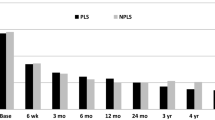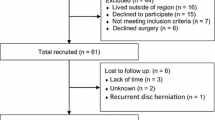Abstract
Purpose
We aimed to identify patient characteristics associated with favourable long-term outcomes after lumbar total disc replacement (TDR).
Methods
We analysed a cohort of 82 patients with degenerative disc and chronic low back pain (LBP) who were treated with TDR and originally participated in a randomised trial comparing TDR and multidisciplinary rehabilitation. Potential predictors were measured at baseline, and the outcomes assessed 8 years after they received allocated treatment. Outcome measures were dichotomised according to whether the participants achieved a clinically important functional improvement (15 points or more on the Oswestry Disability Index, ODI) (primary outcome) and whether they were employed at 8-year follow-up (secondary outcome). Associations between potential predictors and outcomes were modelled using logistic regression. For the secondary outcome, the results were also organised in a prediction matrix and expressed as probabilities.
Results
For 71 patients treated with TDR according to protocol, the follow-up time was 8 years. For a subgroup of 11 patients randomised to rehabilitation who crossed over and received TDR, the median postoperative follow-up time was 72 (range 41–88) months. Of all assessed baseline variables, only presence of Modic changes (type 1 and/or 2) was statistically significantly associated with an improvement of ≥ 15 ODI points. The probability of employment at 8-year follow-up was 1% for patients with ≥ 1 year of sick leave, comorbidity, ODI ≥ 50 and ≤ 9 years of education prior to treatment, and 87% for patients with < 1 year of sick leave, no comorbidity, ODI < 50 and higher education.
Conclusions
Patients with Modic changes prior to the TDR surgery were more likely to report a clinically important functional improvement at long-term follow-up. Comorbidity, low level of education, long-term sick leave and high ODI score at baseline were associated with unemployment at long-term follow-up.


Similar content being viewed by others
References
Jacobs W, Van der Gaag NA, Tuschel A, de Kleuver M, Peul W, Verbout AJ, Oner FC (2012) Total disc replacement for chronic back pain in the presence of disc degeneration. Cochrane Database Syst Rev (Online) 9:CD008326. https://doi.org/10.1002/14651858.CD008326.pub2
Ding F, Jia Z, Zhao Z, Xie L, Gao X, Ma D, Liu M (2017) Total disc replacement versus fusion for lumbar degenerative disc disease: a systematic review of overlapping meta-analyses. Eur Spine J 26:806–815. https://doi.org/10.1007/s00586-016-4714-y
Lemaire JP, Carrier H, el Sariali H, Skalli W, Lavaste F (2005) Clinical and radiological outcomes with the Charite artificial disc: a 10-year minimum follow-up. J Spinal Disord Tech 18:353–359
David T (2007) Long-term results of one-level lumbar arthroplasty: minimum 10-year follow-up of the CHARITE artificial disc in 106 patients. Spine 32:661–666. https://doi.org/10.1097/01.brs.0000257554.67505.45
Guyer RD, McAfee PC, Banco RJ, Bitan FD, Cappuccino A, Geisler FH, Hochschuler SH, Holt RT, Jenis LG, Majd ME, Regan JJ, Tromanhauser SG, Wong DC, Blumenthal SL (2009) Prospective, randomized, multicenter Food and Drug Administration investigational device exemption study of lumbar total disc replacement with the CHARITE artificial disc versus lumbar fusion: five-year follow-up. Spine J 9:374–386. https://doi.org/10.1016/j.spinee.2008.08.007
Skold C, Tropp H, Berg S (2013) Five-year follow-up of total disc replacement compared to fusion: a randomized controlled trial. Eur Spine J. https://doi.org/10.1007/s00586-013-2926-y
Siepe CJ, Heider F, Wiechert K, Hitzl W, Ishak B, Mayer MH (2014) Mid- to long-term results of total lumbar disc replacement: a prospective analysis with 5- to 10-year follow-up. Spine J 14:1417–1431. https://doi.org/10.1016/j.spinee.2013.08.028
Guyer RD, Pettine K, Roh JS, Dimmig TA, Coric D, McAfee PC, Ohnmeiss DD (2016) Five-year follow-up of a prospective, randomized trial comparing two lumbar total disc replacements. Spine 41:3–8. https://doi.org/10.1097/brs.0000000000001168
Park SJ, Lee CS, Chung SS, Lee KH, Kim WS, Lee JY (2016) Long-term outcomes following lumbar total disc replacement using ProDisc-II: average 10-year follow-up at a single institute. Spine 41:971–977. https://doi.org/10.1097/brs.0000000000001527
Furunes H, Storheim K, Brox JI, Johnsen LG, Skouen JS, Franssen E, Solberg TK, Sandvik L, Hellum C (2017) Total disc replacement versus multidisciplinary rehabilitation in patients with chronic low back pain and degenerative discs: eight-year follow-up of a randomized controlled multicenter trial. Spine J. https://doi.org/10.1016/j.spinee.2017.05.011
Hellum C, Johnsen LG, Gjertsen O, Berg L, Neckelmann G, Grundnes O, Rossvoll I, Skouen JS, Brox JI, Storheim K (2012) Predictors of outcome after surgery with disc prosthesis and rehabilitation in patients with chronic low back pain and degenerative disc: 2-year follow-up. Eur Spine J 21:681–690. https://doi.org/10.1007/s00586-011-2145-3
Gornet MF, Schranck F, Wharton ND, Beall DP, Jones E, Myers ME, Hipp JA (2014) Optimizing success with lumbar disc arthroplasty. Eur Spine J 23:2127–2135. https://doi.org/10.1007/s00586-014-3309-8
Hellum C, Johnsen LG, Storheim K, Nygaard OP, Brox JI, Rossvoll I, Ro M, Sandvik L, Grundnes O (2011) Surgery with disc prosthesis versus rehabilitation in patients with low back pain and degenerative disc: two year follow-up of randomised study. BMJ 342:d2786. https://doi.org/10.1136/bmj.d2786
Fairbank JC, Pynsent PB (2000) The Oswestry Disability Index. Spine 25:2940–2952
Statistics Norway (1984) Standard classifications of socioeconomic status. Statistics Norway, Oslo
Statistics Norway (1998) Standard classification of occupations. Statistics Norway, Oslo
Derogatis LR, Lipman RS, Rickels K, Uhlenhuth EH, Covi L (1974) The Hopkins Symptom Checklist (HSCL): a self-report symptom inventory. Behav Sci 19:1–15
Waddell G, Newton M, Henderson I, Somerville D, Main CJ (1993) A Fear-Avoidance Beliefs Questionnaire (FABQ) and the role of fear-avoidance beliefs in chronic low back pain and disability. Pain 52:157–168
Ware JE Jr, Sherbourne CD (1992) The MOS 36-item short-form health survey (SF-36). I. Conceptual framework and item selection. Med Care 30:473–483
Uden A, Astrom M, Bergenudd H (1988) Pain drawings in chronic back pain. Spine 13:389–392
Legaye J, Duval-Beaupere G, Hecquet J, Marty C (1998) Pelvic incidence: a fundamental pelvic parameter for three-dimensional regulation of spinal sagittal curves. Eur Spine J 7:99–103
Modic MT, Steinberg PM, Ross JS, Masaryk TJ, Carter JR (1988) Degenerative disk disease: assessment of changes in vertebral body marrow with MR imaging. Radiology 166:193–199
Masharawi Y, Kjaer P, Bendix T, Manniche C, Wedderkopp N, Sorensen JS, Peled N, Jensen TS (2008) The reproducibility of quantitative measurements in lumbar magnetic resonance imaging of children from the general population. Spine 33:2094–2100. https://doi.org/10.1097/BRS.0b013e31817f19f7
Luoma K, Riihimaki H, Luukkonen R, Raininko R, Viikari-Juntura E, Lamminen A (2000) Low back pain in relation to lumbar disc degeneration. Spine 25:487–492
Fujiwara A, Tamai K, Yamato M, An HS, Yoshida H, Saotome K, Kurihashi A (1999) The relationship between facet joint osteoarthritis and disc degeneration of the lumbar spine: an MRI study. Eur Spine J 8:396–401
Aprill C, Bogduk N (1992) High-intensity zone: a diagnostic sign of painful lumbar disc on magnetic resonance imaging. Br J Radiol 65:361–369. https://doi.org/10.1259/0007-1285-65-773-361
Berg L, Neckelmann G, Gjertsen O, Hellum C, Johnsen LG, Eide GE, Espeland A (2012) Reliability of MRI findings in candidates for lumbar disc prosthesis. Neuroradiology 54:699–707. https://doi.org/10.1007/s00234-011-0963-y
Geisser S (1993) Predictive inference. Chapman and Hall, New York
Laustsen AF, Bech-Azeddine R (2016) Do Modic changes have an impact on clinical outcome in lumbar spine surgery? A systematic literature review. Eur Spine J. https://doi.org/10.1007/s00586-016-4609-y
Cougot B, Petit A, Paget C, Roedlich C, Fleury-Bahi G, Fouquet M, Menu P, Dubois C, Geraut C, Roquelaure Y, Tripodi D (2015) Chronic low back pain among French healthcare workers and prognostic factors of return to work (RTW): a non-randomized controlled trial. J Occup Med Toxicol 10:40. https://doi.org/10.1186/s12995-015-0082-5
Grovle L, Haugen AJ, Keller A, Natvig B, Brox JI, Grotle M (2010) The bothersomeness of sciatica: patients’ self-report of paresthesia, weakness and leg pain. Eur Spine J 19:263–269. https://doi.org/10.1007/s00586-009-1042-5
McGirt MJ, Sivaganesan A, Asher AL, Devin CJ (2015) Prediction model for outcome after low-back surgery: individualized likelihood of complication, hospital readmission, return to work, and 12-month improvement in functional disability. Neurosurg Focus 39:E13. https://doi.org/10.3171/2015.8.focus15338
Nordeman L, Gunnarsson R, Mannerkorpi K (2014) Prognostic factors for work ability in women with chronic low back pain consulting primary health care: a 2-year prospective longitudinal cohort study. Clin J Pain 30:391–398. https://doi.org/10.1097/AJP.0b013e3182a0dd06
Johnsen LG, Hellum C, Nygaard OP, Storheim K, Brox JI, Rossvoll I, Leivseth G, Grotle M (2013) Comparison of the SF6D, the EQ5D, and the Oswestry disability index in patients with chronic low back pain and degenerative disc disease. BMC Musculoskelet Disord 14:148. https://doi.org/10.1186/1471-2474-14-148
van Hooff ML, Mannion AF, Staub LP, Ostelo RW, Fairbank JC (2016) Determination of the Oswestry Disability Index score equivalent to a “satisfactory symptom state” in patients undergoing surgery for degenerative disorders of the lumbar spine—a Spine Tango registry-based study. Spine J 16:1221–1230. https://doi.org/10.1016/j.spinee.2016.06.010
Peng B, Fu X, Pang X, Li D, Liu W, Gao C, Yang H (2012) Prospective clinical study on natural history of discogenic low back pain at 4 years of follow-up. Pain Phys 15:525–532
Geisler FH, Guyer RD, Blumenthal SL, McAfee PC, Cappuccino A, Bitan F, Regan JJ (2008) Patient selection for lumbar arthroplasty and arthrodesis: the effect of revision surgery in a controlled, multicenter, randomized study. J Neurosurg Spine 8:13–16. https://doi.org/10.3171/spi-08/01/013
Acknowledgements
Maren Hjelle Guddal: collecting and punching data. Marianne Bakke Johnsen: collecting and punching data. Eira Kathleen Ebbs: language help.
Author information
Authors and Affiliations
Corresponding author
Ethics declarations
Conflict of interest
None of the authors has any potential conflict of interest.
Funding
The study was funded by Oslo University Hospital, South Eastern Norway Regional Health Authority (Grant no. 2007082) and EXTRA funds from the Norwegian Foundation for Health and Rehabilitation through the Norwegian Back Pain Association ((Grant no. 2012/2/0236). The funders had no role in the study design, data collection, data analysis, data interpretation, or writing of the report.
Rights and permissions
About this article
Cite this article
Furunes, H., Hellum, C., Brox, J.I. et al. Lumbar total disc replacement: predictors for long-term outcome. Eur Spine J 27, 709–718 (2018). https://doi.org/10.1007/s00586-017-5375-1
Received:
Revised:
Accepted:
Published:
Issue Date:
DOI: https://doi.org/10.1007/s00586-017-5375-1




